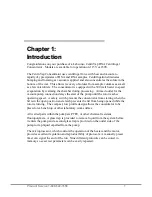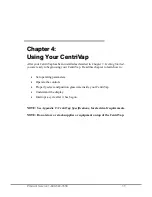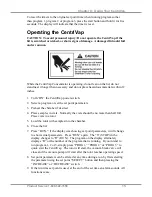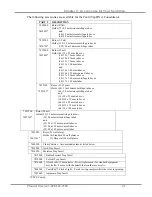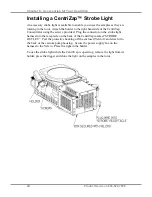
Chapter 3: Getting Started
Product Service 1-800-522-7658
9
Diaphragm vacuum pumps sold by Labconco have wetted parts either made
from PTFE or protected by PTFE coatings and are suitable for nearly all
procedures.
When using compounds in the CentriVap that are hostile to the materials of
construction, it is imperative that the equipment is appropriately maintained.
After each run, clean up all residues, spills and materials that might have
splashed in the chamber using agents suitable for the substance involved.
If the compounds used attack acrylic, consider using the optional glass
chamber lid. Contact Labconco for ordering information.
If optional secondary traps are used, monitor their condition often and
replace them when they are saturated. A new acid trap is off-white and
changes color to purple when used up. A new moisture trap is blue and
changes color to pink when it is used up. The solvent trap molecular sieve
does not change color when saturated so extra care must be taken to
determine when a replacement cartridge should be installed.
Solvent Safety Precautions
CAUTION: The CentriVap is not classified as “explosion proof.” It has
been designed with safety as a primary
consideration
and should be used in a
prudent manner using “good laboratory practices.” It has been designed
for use with compounds as described in the United States National Electrical
Code Class I, Group D. The heater may be programmed to run as hot as
100°C, however, the heater element may normally run at 110°C. A thermal
fuse limits the heater to a maximum temperature of 141°C. It is important
that the solvents used are compatible with these temperatures. Do not
evaporate solvents that have an autoignition temperature below 180°C. Do
not evaporate solvents that are classified as Group A, B, or C by the
National Electrical Code. Evaporate only non-flammable or Group D
solvents with autoignition temperatures 180°C or above. Use of other
compounds could cause an explosion.
Summary of Contents for CentriVap DNA Systems
Page 1: ...CentriVap DNA Systems Models 7970010 7970011 7970030 7970035 7970037...
Page 32: ...Appendix A CentriVap Components Product Service 1 800 522 7658 28...
Page 33: ...Product Service 1 800 522 7658 29 Appendix B CentriVap Dimensions...
Page 35: ...Appendix C CentriVap Specifications Product Service 1 800 522 7658 31...





